
For decades, many Americans shared a common misperception that Indigenous people feared the geysers at Yellowstone. / THF120298
Until recently, much of the American public has shared a common misperception that few Indigenous people had ever ventured within the boundaries of what became Yellowstone National Park. Story had it that these people were afraid of the geysers, or that they felt that the hissing steam vents were signs of angry gods or evil spirits. In fact, the presence of Indigenous Americans was purposefully erased from the story of Yellowstone National Park, beginning with the first white “scientific” expedition there in 1871. This erasure, which lasted through most of the park’s history, is only recently beginning to change.
Some Indigenous people, in their pursuit of the large herds of bison to the east, created a trail that passed near what is now known as Mammoth Hot Springs. / THF120351
Archaeological evidence now indicates that as far back as 10,000 years ago, several bands of Indigenous people regularly passed through this area, primarily hunting bison, bighorn sheep, elk, and deer. In historic times, the area continued to serve as a crossroads for many Indigenous groups—including Crow, Shoshone, Bannock, Blackfoot, Nez Perce, and Flathead—who followed the Yellowstone River and other waterways through what eventually became the boundaries of the park. They tracked small buffalo herds, elk, and deer in the mountains and forests during the summer months and followed these animals to the warmer geothermal area of the Yellowstone Basin during the bitter winter months. Some of these groups crossed through the area to pursue the great herds of bison in the plains farther east, creating a trail that passed through the area now known as Mammoth Hot Springs and stretching eastward across what is known today as Lamar Valley. Early white hunters, trappers, and explorers not only followed the trails that Indigenous people created, but it is from these people that they first heard the fantastic stories of geothermal wonders in the Yellowstone Basin.
Many early photographs of the wonders of Yellowstone, like this “Grand Group” of geysers, were probably taken by William Henry Jackson, one of the people who accompanied Ferdinand Hayden on his 1871 expedition through what would become the park. / THF120369
The process of Indigenous erasure in Yellowstone began in earnest with the Hayden expedition of 1871—a large, government-funded expedition led by geologist Ferdinand Hayden to study, collect specimens in, and map out the confines of the Yellowstone “wonderland” that had been receiving so much recent attention. Hayden and members of his expedition were able to observe firsthand the places that had been described primarily in stories told by Shoshone and Bannock people—astonishing places like “The White Mountain” (which became known as Mammoth Hot Springs) and the spectacular geysers, bubbling mud pots, and hissing steam vents situated within the geothermal area of the Yellowstone Basin. As a result of this expedition, Hayden laid claim to this unique landscape on behalf of the United States government and the American people, choosing to ignore the longstanding use of the region by Indigenous people. Instead, the expedition report pointed to Yellowstone’s wonders as proof of the country’s “exceptionalism”—that is, Americans’ long-sought evidence that the United States was unique and exceptional when compared with other nations of the world.
Photo of "Sheepeater" Shoshone, William Henry Jackson, 1871. / Public domain photo from National Park Service
By the time of the Hayden Expedition, the only Indigenous people still known to inhabit the area were a by-then considered poor and lowly band of Eastern Shoshone called Sheepeaters (Tukudeka or Tukadika). A wealth of recent archaeological information has pointed to the conclusion that this band had inhabited and roamed this area for thousands of years—not the mere 200 years that early white explorers surmised (a story that then became widely accepted). These people had developed a remarkably sustainable way of life, taking advantage of the once-large population of bighorn sheep for food, clothing, blankets, tools, and bows. Early white trappers observed this band’s self-confidence, intelligence, friendliness, and willingness to trade their fine-quality hide clothing, horn bows, and obsidian arrowheads. Unfortunately, the bighorn sheep population plummeted as the result of diseases brought by white settlers’ domestic sheep. White hunters and settlers also decimated other game and polluted the streams in which these people had fished. No wonder, then, that by the 1870s white explorers of the area described these people as starving and miserable.
In 1903, this monumental stone gateway was completed to mark the north entrance to Yellowstone National Park. The words “for the benefit and enjoyment of the people,” inscribed above the arch, are taken directly from the legislation that created Yellowstone back in 1872. / THF120280
The widely publicized and highly celebrated Hayden report rapidly led to the creation of a bill to set the area aside as a national park, a “resort for all classes of people from all portions of the world,” a democratic landscape of tourism. When the question of Indigenous claims to the area under the 1868 Treaty of Fort Laramie was raised, the argument was made that the land was simply too hostile for Indigenous people to live there. Though this was not true, Hayden’s expedition report had already justified the removal of Indigenous people from the area. The bill passed easily, with the help of aggressive lobbying by the Northern Pacific Railroad and the strong desire by members of Congress to use the bill as a way to help unify a Civil War-torn nation. The Yellowstone National Park Protection Act (or, simply, the Yellowstone Act) was placed on President Ulysses S. Grant’s desk on March 1, 1872. President Grant signed it without fanfare. During the 1870s, the Sheepeaters were easily rounded up and exiled to the Wind River (Wyoming) and Fort Hall (Idaho) reservations to live with other bands of Shoshone, along with Bannock and Arapaho people. 
Early tourists typically boarded horse-drawn carriages to view the sites at Yellowstone National Park. / THF200464
When Yellowstone became a national park, no funds were allotted to administer or manage it. But an 1877 incident involving an encounter between another Indigenous group and two groups of tourists in the park changed that. The incident involved a group of Nez Perce (Nii mi’ipuu) crossing through the park in an epic flight to avoid the U.S. Army, who was pursuing them to force their removal from their ancestral homeland in eastern Oregon to a tiny reservation in Washington. This incident, which unfortunately involved violence and hostage-taking, created a national media sensation. Many personal accounts of the episode emerged afterward, with some indication that those who were involved sympathized with the plight of the Nez Perce. The Nez Perce group managed to successfully evade the army until the soldiers finally caught up with them 40 miles south of the Canadian border—in an attempt to join Sitting Bull’s Lakota band.
As a result of the widespread publicity and furor raised by this incident, Congress finally committed some money to managing the park. As tourism increased, Congress pressured Yellowstone park administrators to control the “savages” because it was assumed that they would endanger the park’s visitors. After that time, park administrators aggressively downplayed any presence of Indigenous people, not wanting the park’s well-heeled guests to risk crossing paths with them, or to even be worried that they might. By 1882, all Indigenous groups had been banned from the park.
Sheepeater Cliff was named after the only Indigenous people that lived on in public memory as having inhabited the Yellowstone area. / Photo by NPS/Jim Peaco
Once the real presence of Indigenous people had been erased from the landscape, park superintendents, railroad publicists, and tourists alike could look back—safely, nostalgically, and romantically—on the one-time presence of Indigenous people there. For example, when park administrators came across the remnants of wickiups (temporary shelters made from poles leaned and tied together, covered with brush or grass) eight miles south of Mammoth Hot Springs, they assumed these were made and used by the Sheepeaters. Since this was the only group still in the public memory as having inhabited Yellowstone, they felt that they were honoring their one-time presence by naming the natural feature near there “Sheepeater Cliff”—though this band did not live in that area and likely did not build these shelters. Once established, the perception that no Indigenous people had ever set foot inside the current boundaries of Yellowstone National Park (except for the Sheepeaters) persisted for decades.
In recent years, however, archaeologists, historians, and Indigenous activists have begun to correct the narrative of Indigenous presence and habitation on this land. In addition, administrators at Yellowstone National Park have also been making a concerted effort to elevate Indigenous voices and incorporate Indigenous knowledge systems into their research and programs (see, for example: https://roadtrippers.com/magazine/yellowstone-150-native-american-voices/ and https://www.nps.gov/yell/getinvolved/150-years-of-yellowstone.htm). Today, they recognize at least 27 distinct American tribes that have historic and present-day connections to the land and resources of the park. As champions of ecological connectivity, Indigenous people have been galvanizing action to protect Yellowstone’s wildlife, helping to relocate bison culled from the park, raising awareness on living with bears and wolves in the wider landscape, and enlightening administrators and the public on other aspects of environmental conservation related to the Yellowstone ecosystem. For the 150th anniversary of the park in 2022, administrators have been “shining a light” on Indigenous people whose past, present, and future are an essential part of Yellowstone’s story. As Cam Sholly, superintendent of Yellowstone National Park, proclaims, “This isn’t just about the last century and a half. We also want to use this anniversary to do a better job of fully recognizing many American Indian nations that lived in this area for thousands of years prior to Yellowstone becoming a park…. The engagement we’re doing now will help set a stronger foundation for collaboration well into the future.”
As erasure shifts toward inclusion—through published materials, behind-the-scenes collaboration, and public programming—the historic and present-day connections of Indigenous people to Yellowstone National Park will continue to play an important role in the park’s future.
Donna R. Braden is Senior Curator and Curator of Public Life at The Henry Ford. For recent books aimed at greater inclusion of Indigenous people in Yellowstone’s history, she recommends Saving Yellowstone: Exploration and Preservation in Reconstruction America by Megan Kate Nelson (2022) and Wonderlandscape: Yellowstone National Park and the Evolution of an American Cultural Icon by John Clayton (2017).
Wyoming, Yellowstone National Park, nature, national parks, Indigenous peoples, by Donna R. Braden, 21st century, 2020s, 19th century
OUT!: LGBTQ+ Visibility and Identity
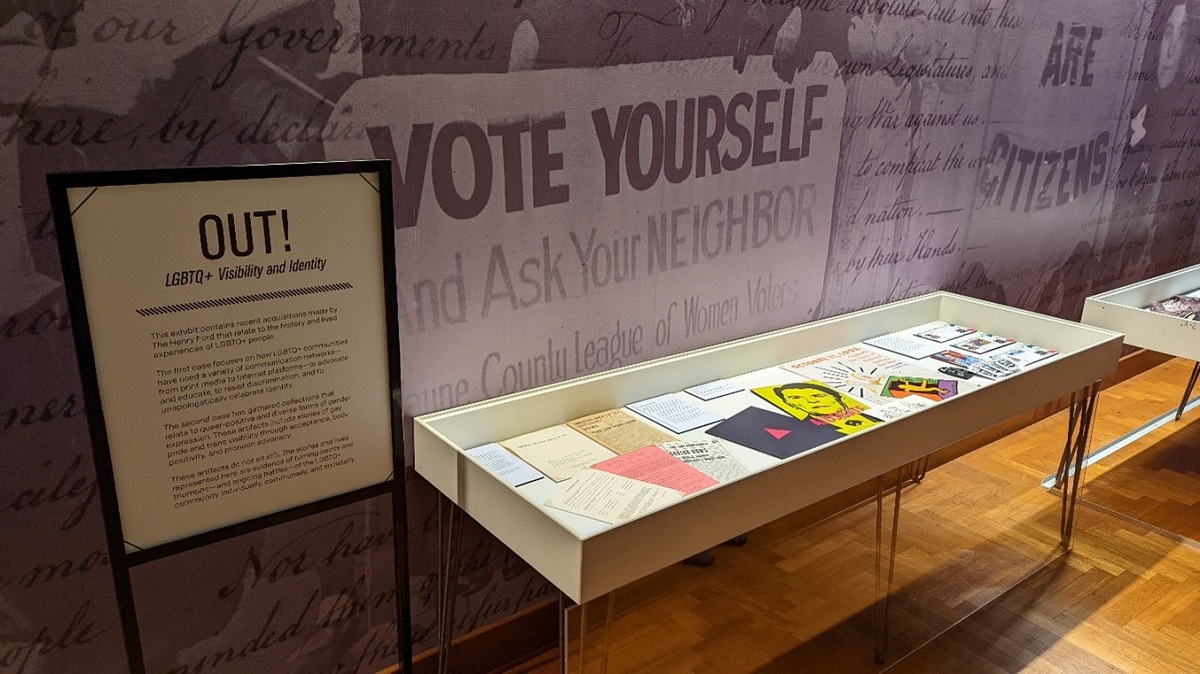
Photo by Kristen Gallerneaux/Katherine White
In 2022, The Henry Ford displayed a temporary exhibit, OUT!: LGBTQ+ Visibility and Identity, at Henry Ford Museum of American Innovation. The exhibit, co-curated by Kristen Gallerneaux and Katherine White and featuring items from The Henry Ford's collections, contained recent acquisitions that relate to the history and lived experiences of LGBTQ+ people.
The first theme explored in this exhibit was how LGBTQ+ communities have used a variety of communication networks—from print media to Internet platforms—to advocate and educate, to resist discrimination, and to unapologetically celebrate identity.
The second major theme gathered collections that relate to queer-positive and diverse forms of gender expression. These artifacts included stories of gay pride and trans visibility through acceptance, body positivity, and pronoun advocacy.
These artifacts do not sit still. The stories and lives represented in OUT!: LGBTQ+ Visibility and Identity are evidence of turning points and triumphs—and ongoing battles—of the LGBTQ+ community individually, communally, and societally.
Getting the Word Out
In the 1960s, LGBTQ+ people faced a largely unaccepting American society and legal landscape that restricted how they could express themselves. Queer bars and clubs were among the only private, “safe” spaces, for LGBTQ+ patrons but they were also easy targets for police, who harassed and arrested patrons. On June 28, 1969, New York City police raided the Stonewall Inn, a gay club in Greenwich Village. A riot ensued.
Queer bars and clubs also became sites of community and connection—even amidst persecution and harassment—and became fertile soil for the burgeoning queer liberation movement. LGBTQ+ newspapers were distributed in these spaces, broadcasting news unlikely to be shared in mainstream media. Print media like these unified queer/LGBTQ+ people in the fight for acceptance and equality through sharing manifestos, organizing protests, and recruiting members.
Today, we recognize the legacy of the Stonewall Riots as the genesis for the Pride marches that celebrate the LGBTQ+ community every June, in cities big and small across America. .jpg?sfvrsn=e6cd3601_2)
THF627212.jpg?sfvrsn=b2cd3601_2)
THF627336
These fliers were created by New York City’s chapter of The Mattachine Society, one of the oldest gay rights groups in America, in the months following the Stonewall Riot. They illustrate the urgency felt by the queer community in the wake of persistent and brutal police violence.
Raising Awareness
In the early and mid-1980s, activist collectives formed to raise awareness of HIV and AIDS. This advocacy was critical, since government and public health organizations initially refused to act or acknowledge the developing crisis. Misinformation about HIV and AIDS transmission was widespread, and so LGBTQ leaders and allies spoke up—demanding an end to negligence, access to testing, treatment options, and vetted public education about HIV prevention..jpg?sfvrsn=aacd3601_2)
THF179775.jpg?sfvrsn=9acd3601_2)
THF627370
The Silence=Death Collective’s “AIDSgate” poster condemns then-president Ronald Reagan’s lack of response to the AIDS epidemic. In 1981, the first AIDS cases in the United States; President Reagan did not recognize AIDS in a public speech until September 1985..jpg?sfvrsn=eecd3601_2)
THF627366.jpg?sfvrsn=86cd3601_2)
THF627364
Howard Cruse, author of the acclaimed graphic novel Stuck Rubber Baby, uses the slogan of the Gay Liberation Front in the top drawing above: “We’re here, we’re queer, get used to it!” The “Gay is Good” illustration mimics historical photographs of protestors at the 1969 Stonewall Uprising that were also referenced in the “Gay Liberation” poster by Su Negrin, Peter Hujar, and Suzanne Bevier.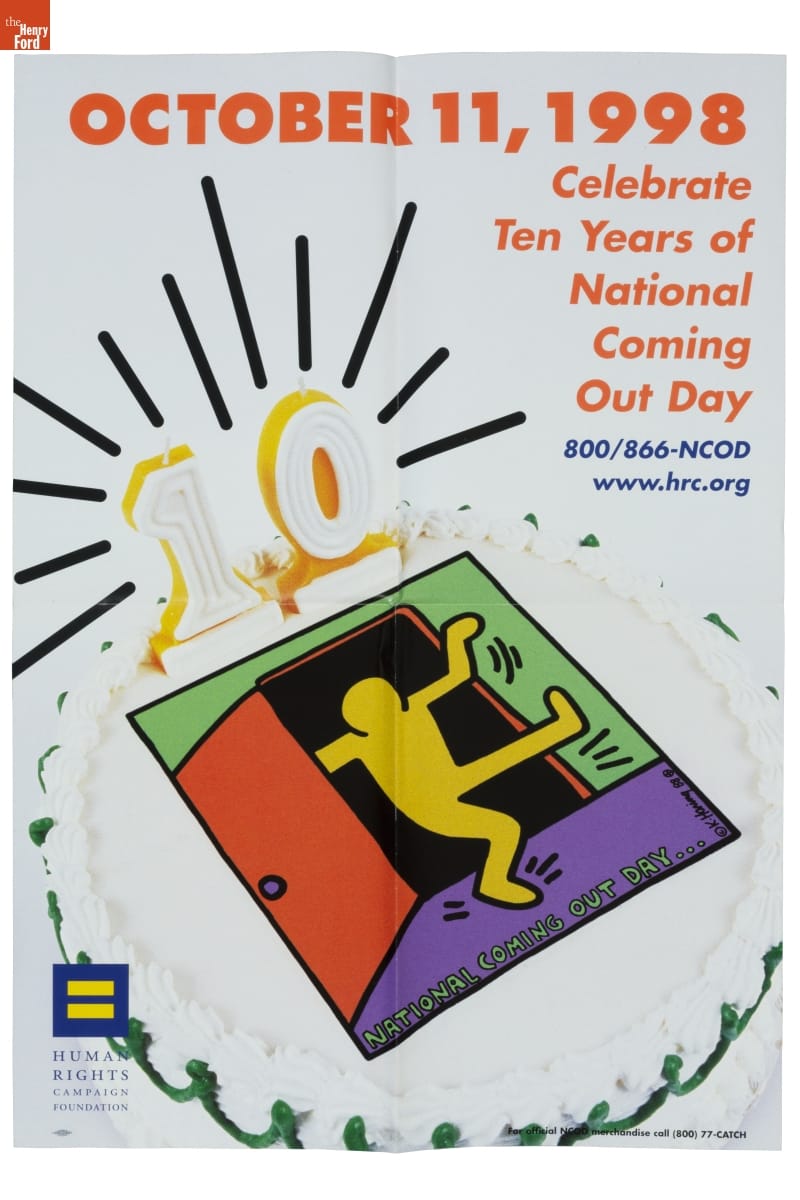
THF190487
In 1988, Richard Eichberg and Jean O’Leary founded Coming Out Day to provide resources for LGBTQ+ people wishing to publicly declare their identity. The pair believed that “coming out” would promote solidarity and acceptance while reducing homophobia. The Human Rights Campaign (an LGBTQ+ advocacy and political lobbying group) sponsors this event in the United States. This poster commemorates the 10th anniversary of the observance, which remains active in 2022. The logo of a person dancing their way out of a closet depicted on the cake on this poster references artist Keith Haring’s original NCOD logo.
Online Identity & Safe Spaces
Online platforms can act as digital “safe spaces” for LGBTQ+ community-building. Beginning with Usenet bulletin board systems in the 1980s and transitioning to LiveJournal, Twitter, and Tumblr in the 2000s, these sites can act as support networks for LGBTQ+ people—including those who live in isolated areas or in situations where openly exploring identity poses challenges AFK (away from keyboard). 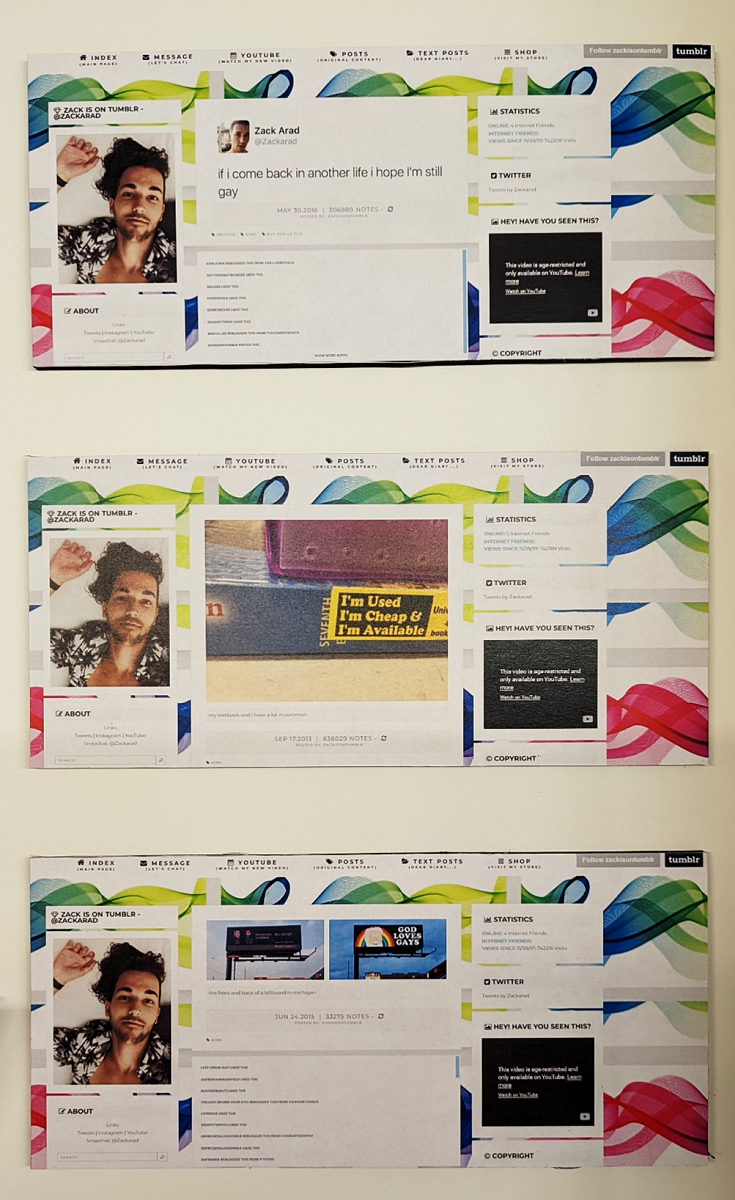
Photo by Kristen Gallerneaux/Katherine White
Zack Arad launched a microblog on July 21, 2010. Arad, who self-identifies as gay, has been active on social media since he was a teenager. His popular Tumblr blog and YouTube vlogs explore themes like gay pride, pop culture, humor, dating, and political issues.
Photo by Kristen Gallerneaux/Katherine White
This “mini-quilt” was created by Zak Foster, a textile artist who identifies as gay and has a strong online following for their work, selling one-of-a-kind upcycled quilts on Etsy. With Grace Rother, Foster also created this collection of “zines,” and distributed them online “as a love offering … to all the queer folks in the quilting community.”
Identity & Solidarity
Buttons, patches, badges, and pins are consciousness-raising, inexpensive, quick to create, and able to be distributed widely. Wearing a button can be a method of activism. When simply being “out” as LGBTQ+ means possible danger and discrimination, choosing to wear a visible symbol of queerness is a courageous act. .jpg?sfvrsn=becd3601_2)
THF189705
The cap above was worn by a member of a California-based gay motorcycle club. Among the oldest gay organizations in the United States, these clubs emphasized hypermasculinity, which appealed to many gay men who had long been stereotyped as effeminate.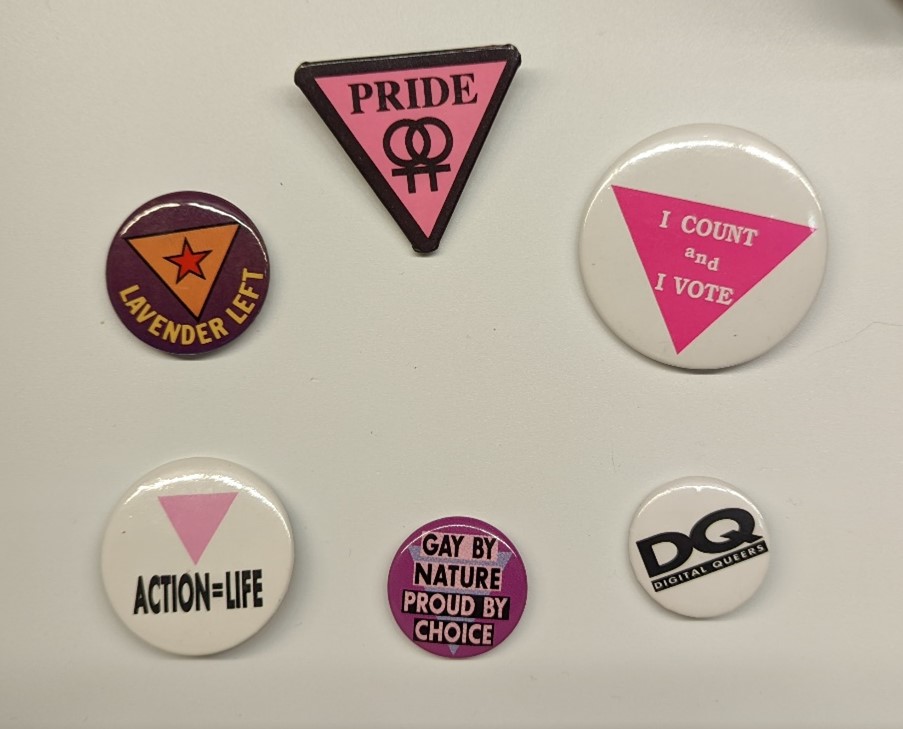
Photo by Kristen Gallerneaux/Katherine White
Many of the buttons featured here use symbols or terms that were once weaponized against the LGBTQ+ community but were later reclaimed. The inverted pink triangle, for example, has its roots in the Holocaust, when Nazis forced queer people to wear a pink triangle as a form of identification and persecution. By repurposing these symbols, a shared and recognizable language of identity and solidarity is created among LGBTQ+ people and allies.
Trans Acceptance
Transgender and nonbinary people have always existed, across time and in every corner of the world—just as have gay, bisexual, lesbian, and other queer communities. But acceptance by the broader world has been difficult to achieve. Even the early leaders of the LGBTQ+ equality movement pushed the transgender community to the fringes. For many transgender and nonbinary individuals, the realization that their gender identity does not align with their assigned-at-birth gender comes long before even their own acceptance and celebration of it.
THF190453
THF611162
Miley Kirby came out publicly and applied trans flag patches to her medic bag during Detroit’s Black Lives Matter protests, which held supplies used to provide medical care to fellow protestors. Kirby is visible carrying this same bag in the center of the press photo above, published in the Detroit News during the Black Lives Matter protests of Summer 2020.
“The people I met at the [George Floyd] protest were one of the first groups of people that encouraged me to be me. They refused to let me cop out on pronouns, names, or hand-waving of my transness for others comfort. We yelled our message in the streets, why not scream your identity to the world? My time in those protests found me my voice as Miley Kirby, or at least the beginning of one.” – Miley Kirby 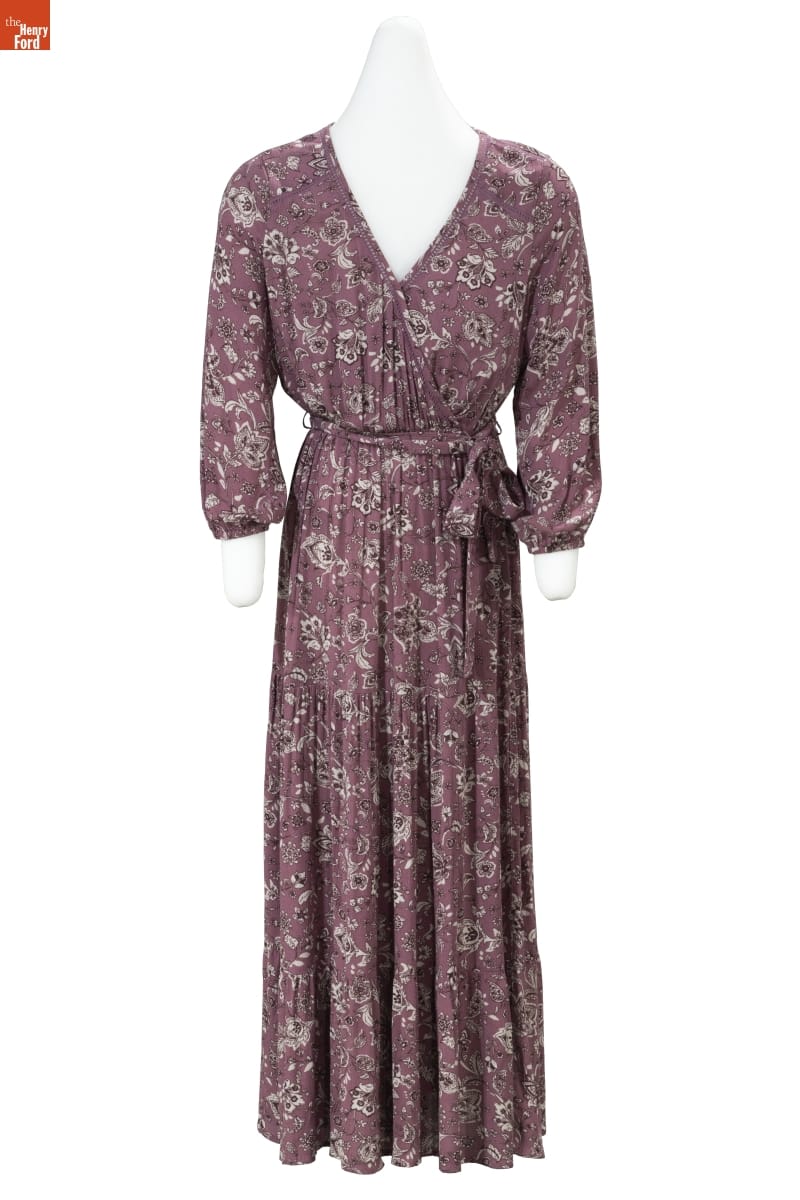
THF190458
Allie Zecivic listened to an insistent inner voice and purchased this dress, her first article of women’s clothing. It helped her to accept her gender identity as a transwoman.
“Hot Topic skinny jeans and too tight graphic tees were alright, but this was a dress. A long, flowy, spinny dress. I spent a lot of time sitting alone in my room wearing it, my heart racing and the paranoia spinning horrible outcomes in my head, but it felt right. The validation that dress brought was freeing. It was this feeling in the face of trepidation of being caught, that solidified my need for more. And such my wardrobe grew.” – Allie Zecivic 
THF190456
THF190457
Laura Bowman began the medical transition to female with these hormone replacement therapy medications. She crossed out her “deadname”—the male name she was given at birth—and kept these bottles as symbols of her journey.
“Hormones don't make a transperson trans, but for many of us they are the beginning of the end. The end of the old life, and the beginning of a new experience, a new chance to be who we want to be, to make the outside fit how we feel inside. When I first picked up these pill bottles, I felt a giant weight off my chest as it felt like I was going to be able to make some progress on that person in the mirror and come to like her just a little better. The major part of that comes when you change the way you perceive yourself, but damn do the hormones help!” –Laura Bowman
Body Positive
Carrie Metz-Caporusso is an artist and tattooer who identifies as queer and non-binary. They began tattooing in 2011 and are committed to challenging traditions in tattooing culture that sometimes stigmatize LGBTQ+ and larger-bodied people. After experiencing fat shaming in the tattooing world, Carrie brainstormed a way to celebrate—rather than conceal—plus-sized body types with custom “roll flower” tattoos. These tattoos align with the body positivity movement by embracing the natural folds and creases on client’s backs or sides, which serve as a “stem” for flowers and leaves emerging from above and below.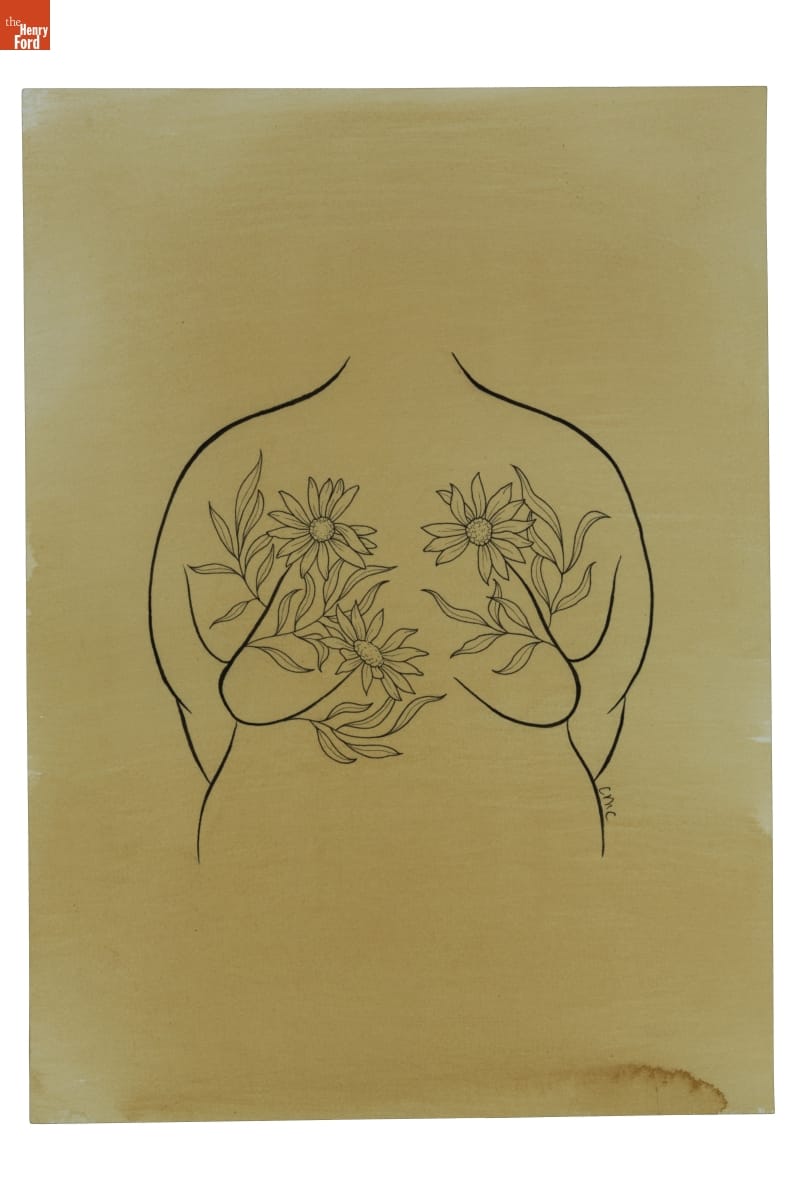
THF190488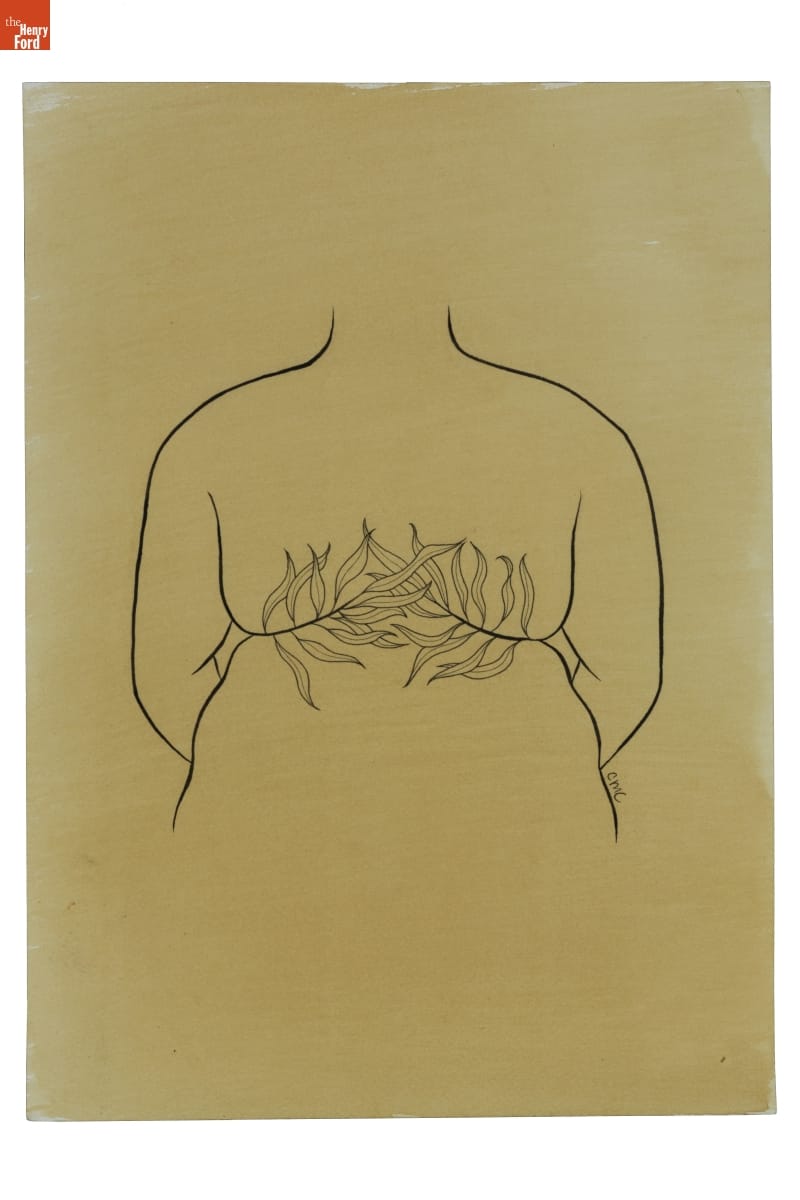
THF190489
These signature “roll flower” tattoo flash designs were drawn and donated by Metz-Caporusso to The Henry Ford. In 2022, The Henry Ford commissioned Metz-Caporusso to create illustrations for apparel, which will soon be available in museum stores. 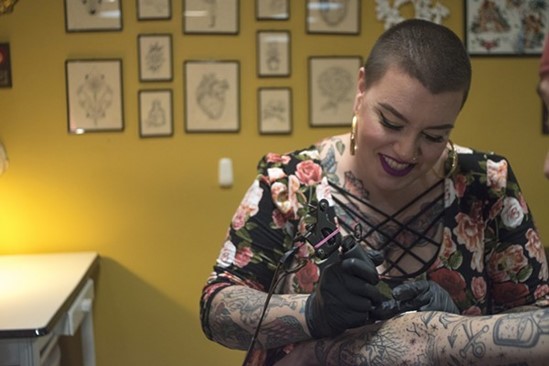
Photo courtesy of Carrie Metz-Caporusso
Mother of the Movement
Marsha “Pay It No Mind” Johnson was a New York City–based drag performer and activist who identified as a gay transvestite (the term transgender was not used at that time).
She was tireless in her advocacy for gay rights. From the mid-1960s on, she was an active presence—often a mischievous instigator—at almost every major uprising, parade, and political action connected to the LGBTQ+ equality movement. She clashed with police during the Stonewall Uprising, helped create the Gay Liberation Front, and participated in AIDS awareness group ACT-UP. With Sylvia Rivera, Johnson was a “house mother” for the Street Transvestite Action Revolutionaries—a political collective and homeless shelter for trans youth of color. Johnson died under suspicious circumstances in 1992—believed by many to be a victim of anti-gay violence.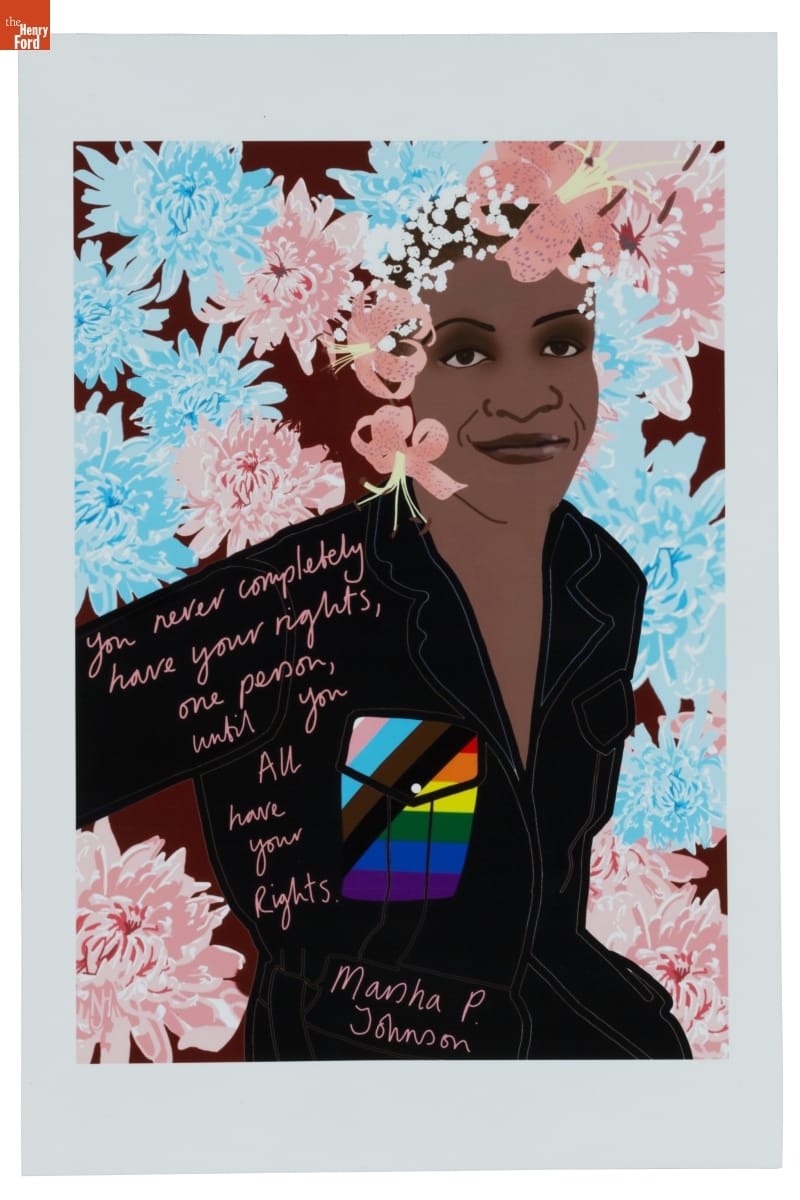
THF190491
This print, created by Julia Feliz in 2018, honors the intersectional legacies of Black LGBTQ+ leaders, as well as Daniel Quasar’s redesign of the Pride Flag to include stripes for BIPOC (Black, Indigenous, and people of color) and trans people.
Listening to the Community
The stories and lives represented in this exhibit just barely scratch the surface of what it means to be LGBTQ+ in the United States. Visibility often increases vulnerability—and backlash. Bigotry, discrimination, and social justice issues related to equal rights and access continue to impact LGBTQ+ people around the world.
Kristen Gallerneaux, Curator of Communications & Information Technology at The Henry Ford, and Katherine White, Associate Curator at The Henry Ford, collaboratively produced this exhibit and blog.
Henry Ford Museum, by Katherine White, by Kristen Gallerneaux
Old Faithful Inn: The Essence of Rustic

The photograph I came across in The Henry Ford’s archives in 1985. / THF120353
Back in 1985, I was looking through The Henry Ford’s archives for images that depicted vacation destinations to complete a museum book I was writing called Leisure and Entertainment in America. There, in our collection, I came across the most amazing photograph of a hotel that I had ever seen. It looked like the outdoors had been brought inside. A great lobby dominated the scene, featuring a mammoth fireplace made of massive boulders. Real, full-size logs supported the balconies that rose several stories. In the midst of all this grandeur, comfortable Mission-style rockers, settees, and handwoven rugs were scattered about.
What was this place? I wondered. Did it still exist? Could I go there?
This was my first encounter with the Old Faithful Inn, which is situated alongside Yellowstone National Park’s most famous geyser, Old Faithful. As it turns out, Old Faithful Inn is quite significant in its own right, as it was not only the first rustic hotel of the Western national parks, but it also set the standard for rustic lodgings and manmade structures in other national parks.
What was the story behind this unique place?
Photographs like this one of Yellowstone Lake, from the 1870s, encouraged early tourism in the park. Note the man fishing, lower left. / THF120349
During the first few decades after Yellowstone became a national park in 1872, accommodations inside the park were, admittedly, spotty. The small number of well-to-do tourists who could afford the trip to Yellowstone during this time expected the pleasures of the high-class, comfortable lodgings they were used to on their European vacations or nearer to home along the East Coast. The first lodgings near Old Faithful were generally ramshackle establishments, built quickly and cheaply. When a lunch station/hotel constructed there in 1884—nicknamed “The Shack”—burned down, park administrators were actually relieved. They had considered it an eyesore.
Before the Old Faithful Inn existed, the Fountain Hotel—typical of Yellowstone hotels at the time—provided comfortable lodging 10 miles north of Old Faithful. / THF203310
Tourism increased when the Northern Pacific Railroad established the “Grand Tour” route through the park for four- to five-day horse-and-carriage tours. At key stops like Mammoth Hot Springs and Yellowstone Lake, the railroad had built some of the nicer hotels in the park. But Old Faithful was located 10 miles south of the route, and comfortable lodgings were already available at the privately-run Fountain Hotel near the Paint Pots (bubbling mud pots) thermal feature. Railroad executives were reluctant to take a chance on building a hotel so far off the beaten track.
Old Faithful was such a dramatic attraction, it is surprising that it was not part of the original Grand Tour route. / THF120359
But, in 1894, park administrators passed a special regulation that lodging could be situated ⅛ of a mile from Old Faithful geyser rather than the usual ¼ mile required between lodgings and natural features. This changed everything. Within a few years, Harry W. Child, entrepreneurial president of the Yellowstone Park Association (which oversaw the Northern Pacific Railroad’s transportation and lodgings), began making plans to build a respectable hotel at Old Faithful. He initially engaged Seattle-based architect A.W. Spalding, who designed a hotel much like the other Yellowstone hotels that were reminiscent of European and East Coast hotels. Spalding’s design was never built, as it apparently did not meet the expectations of railroad executives.
The Saranac Inn, a rustic lodging on Upper Saranac Lake in the Adirondacks. / THF126056
It was then that Child turned to his young friend—self-taught San Diego-based architect Robert Reamer—to design something more in the manner of rustic “great camps” of the Adirondacks. Combining the influence of California bungalows (especially the idea of bringing the roofline low to the ground) with the rustic trappings of the Adirondack lodge, Reamer designed a hotel that was radically different from anything seen before but seemed to perfectly fit Yellowstone’s exotic setting.
As seen in this 1908–1909 postcard of the front porch, locally obtained lodgepole pines were used for the ground floor of the Inn, while rhyolite rock (which can be glimpsed in the background) formed much of the building’s foundation. / THF120292
Reamer’s design was completed and approved in 1902, and actual construction of the building began in June 1903. It took 13 months to complete, over a long winter that was particularly bitter. About 40 skilled artisans were hired for the work, hailing from nearby Montana towns like West Yellowstone, Gardiner, and Livingston. They were a hardy crew, facing many hardships while making swift work of the construction. Materials were mostly obtained nearby, including lodgepole pine and rhyolite rock (an unusual type of rock produced by Yellowstone’s volcanic eruptions). A temporary sawmill was built eight miles to the south to produce the many boards of lumber needed for the project. A Livingston, Montana, blacksmith named George Colpitts and his assistants hand-forged the wrought-iron work for Old Faithful Inn, including the massive front door hardware, the fireplace clock and tools, and all the original guest room door numbers and locks. The total cost of construction was $140,000.
Original façade of Old Faithful Inn, 1905, before the east and West Wings and the extended front porch were added. / THF120361
When it opened on June 1, 1904, Old Faithful Inn was a dramatic tour de force. It seemed rooted in the landscape, as if it had risen directly from the earth. On its exterior, the steep gable roof dominated (for both aesthetic reasons and the very practical one of having to withstand 20-foot drifts of snow in winter). Cedar shingles covered the roof and upper siding, with dormer windows that seemed to pop out in odd places (some were real, others just decorative). The building’s interwoven log construction not only gave it a look of permanence and solidity but also transformed it, in essence, into a gigantic log cabin.
Postcard of the great hall lobby, 1904–1905. / THF120294
Inside, the great hall rose 76½ feet—seven stories in all—with square and diamond windowpanes that filtered light in. Upright poles and beams supporting each balcony were made from lodgepole pine tree trunks, with thick branches attached to the trunks at Y-shaped angles. Balconies and stairways were supported by smaller pine branches found around the area, adding interest with their twisted, curved, and gnarled shapes. A trapeze-like wooden platform near the ceiling of the Inn, called the “Crow’s Nest,” originally held a string quartet—who performed before dinner so guests could mingle, and after dinner when the lobby was transformed into a dance hall. (The Crow’s Nest unfortunately closed when it was deemed unstable after a disastrous earthquake in 1959). The fireplace dominated: 15 by 15 feet at its base, with eight hearths, and rising to a tapered pyramidal shape of 41 feet high. Near the top of it was a huge 14-foot windup clock designed by Reamer. Electric fixtures simulating candlelight were placed discreetly around the space.
Postcard of the dining room at Old Faithful Inn, 1904–1905. / THF120296
Behind the great hall was the dining room, with split logs covering an open-pitched roof. Similar to the great hall, it was also dominated by a massive stone fireplace. Guests originally sat at long, family-style tables and could obtain a meal for 75 cents. A dinner bell atop the Inn’s rooftop summoned guests to dinner.
A typical room for lodgers in the Old House, circa 1905. / THF120355
The lobby and upper mezzanines were filled with Mission-style tables, settees, rockers, desks, and Old Hickory tables and chairs. (Old Hickory was a Martinsville, Indiana, company founded in 1892 that specialized in rustic furniture made out of hickory, with woven, hickory-rushed seats and backs.) One hundred forty log-walled rooms for lodging led off the great hall, on two floors, to the east and to the west. Rooms were furnished simply, with brass, iron, or wood beds; natural wood dressers, chairs, nightstands, and desks; and washstands with chamber pots. Some had cushioned window seats. The rooms had steam heat and sinks with running water (communal bathrooms were, and still are, available down the hall.) This original set of rooms, which cost four dollars per night to lodge in when the Inn opened, became known as the Old House.
It is believed that Harry Child’s wife Adelaide (or Addy), who accompanied her husband on the initial trip to hire Reamer, had a hand in the furnishings, decorations, and details. The delicacy of the balconies, stairway railings, window placements, and Mission-style furniture shows her influence. As a result of this collaboration, both men and women felt comfortable and relaxed here. The Inn, in essence, neutralized gender and class distinctions, encouraging impromptu encounters and informality.
The radically different look of Old Faithful Inn prompted the National Pacific Railroad to justify it in its promotional materials. / THF120290
Old Faithful Inn was different from the usual lodging, and Northern Pacific Railroad promoters figured they had better explain this to potential guests. They wrote this statement in the Inn’s defense when it first opened, just in case guests rejected the notion of a rustic hotel: “The Inn is not in the least a freaky affair…. It is a thoroughly modern and artistic structure in every respect—modern in its appointments and artistic in the carrying out of an unconventional and original scheme.”
They needn’t have worried about guests’ reactions. Old Faithful Inn was an immediate hit with the public. One guest, a Mrs. E.H. Johnson, in 1905, recounted: “And then we came to the Inn, the most unique and perfect place; it is the craftsman’s dream realized. My room alone is a paradise of restfulness though in a rough and rustic fashion…. At luncheon we had another treat. The dining room has its own charm.”
Old Faithful Inn after the new porch and veranda were completed in 1927. / THF120323
Old Faithful Inn was so popular, in fact, that in 1913–1914, 100 guest rooms were added to create the East Wing. And, in 1927, with the increasing number of tourists coming by automobile, 150 more rooms were added to create the West Wing. Although the interiors of these later rooms were more modern than those in the Old House, a consistent look was maintained on the exterior for an overall cohesive effect. A covered porch was added to the front of the building in 1927—again to accommodate automobile traffic—with an open veranda above for viewing Old Faithful eruptions. (For more on the impact of automobiles on the national parks, see my blog post, “Automobiles Enter the National Parks.”)
The rustic Lodge, shown on this Bryce Canyon pennant, was constructed in 1925. / THF239283
Old Faithful Inn really started something. The railroad companies, who had made the Western national parks accessible and controlled many of the concessions in the early parks, realized that the rustic style suited these places, and the style spread quickly—first to the upscale hotels, then to other manmade structures in the parks. The National Park Service, formed in 1916, eventually chose the rustic style as its standard architecture across the entire park system. This style, which colloquially became known as “Parkitecture,” reached its culmination with the Depression-era projects of the Civilian Conservation Corps.
Old Faithful Inn was a very atypical hotel of its era. Most resort hotels at the time were intended to serve as civilized oases from the wilderness. Old Faithful Inn, the first rustic-style lodge of the West, was designed to fit in and become part of the wilderness experience. Somehow, Robert Reamer recognized this when he created what was truly a one-of-a-kind national park lodging.
Snapshot of the author at Yellowstone National Park in 1985, standing on the Upper Geyser Basin trail with Old Faithful Inn in the background. / Photo courtesy of Donna Braden
Soon after I first viewed the image of the Old Faithful Inn lobby in 1985, my husband and I had the pleasure of visiting Yellowstone National Park, and we stayed at the Old Faithful Inn. Eighty years after that photograph was taken, it was like we had entered it in real life. We stayed in one of those tiny, log-walled, chamber-potted rooms in the Old House. It was noisy but thrilling to be in that room—to become part of that place. We returned to Yellowstone National Park in 2014, almost 30 years later, and have returned year after year since then (except in 2020 because of the COVID-19 pandemic). We have stayed at the Old Faithful Inn every year—in the Old House, the East Wing, and the West Wing. We plan to stay there again when we return to Yellowstone National Park this summer. Somehow, it always feels comfortable, welcoming, and timeless—like we’re coming home.
Snapshot of the author at West Thumb Geyser Basin, Yellowstone National Park, 2014. / Photo courtesy of Donna Braden
Donna R. Braden is Senior Curator and Curator of Public Life at The Henry Ford.
Yellowstone National Park, travel, postcards, nature, national parks, hotels, by Donna R. Braden
 Soybean Harvesting / Photo courtesy of the United Soybean Board
Soybean Harvesting / Photo courtesy of the United Soybean Board
Farmers have only a narrow window of opportunity to harvest their crops. For Michigan soybean growers, that window generally runs from the end of September through November, but is impacted yearly by weather events. By that point in the season, the plant is fully mature and has lost most of its leaves, and only the stalk and pods (with three to four beans per pod) stand in the field (R8 Growth Stage). The seeds are brown and hard at this point, and bean moisture content is 13-15%.
A Close-Up of the Modern Soybean Harvesting Process / Photo courtesy of the United Soybean Board
Harvesting soybeans—to cut the stalk, separate the bean from the pod, clean the bean, and store it until moved from harvester to wagon or truck—requires a multifunctional machine. Soybean growers benefitted from around a century of experimentation with specialized harvest machines when it came time for them to look for the best machine for the job. Farmers need machines that work, and different machines to harvest different crops. The Henry Ford has some of the earliest of these mechanical innovations, each suited to a specific crop—the Ambler mowing machine for hay, models of the Hussey and McCormick reapers for grains, and the Manny combined mower and reaper (one machine adaptable for both crops).
These early-19th-century innovations represented solutions to the problem of how to reduce human labor costs. Farm families often could not meet labor demand during harvest seasons. Too little labor meant lost crops, and lost crops made it difficult for farmers to feed their livestock (hay) or earn income from market crops (grain). Hiring labor was expensive, and even more expensive during peak demand at harvest time.
A century passed between the 1830s, when mechanical reapers and mowing machines first became viable, and the 1930s, when the first Allis-Chalmers All-Crop Harvester entered Michigan soybean fields.
Man Driving an Allis-Chalmers Tractor Pulling an Allis-Chalmers All-Crop Harvester at Michigan and Southfield Roads, Dearborn, Michigan, October 1936 / THF286727
The Crop
Michigan growers raised different types of beans during the early 20th century. Some raised bush beans (Phaseolus vulgaris), green beans that they harvested by hand when the pod reached the R5 growth stage and seeds had just begun to develop. Wholesale dealers distributed this perishable commodity to grocery stores while processors turned the bush beans into canned green beans. Others raised large fields of beans on contract with the H.J. Heinz Co. After the beans were fully matured and dry, growers harvested the crop by hand, then hauled the crop to a threshing machine that separated the beans from the pods and stems. Employees at Heinz processing plants continued the handwork, sorting beans from debris. Product advertising emphasized this attention to detail that yielded a quality food product.
A different type of bean—the “soy bean” (or soybean, Glycine max)—became increasingly apparent in southeast Michigan during the 1930s. Interest in this new cash crop grew apace with Henry Ford’s investment in soybean research. Scientists at work in the chemical laboratory that Ford built in Greenfield Village confirmed that soybeans had potential as a domestic source for various industrial products. Industrial demand in the region caused growers to seek a harvester suitable to the task.
Soybean Pods Ready for Harvesting / Photo courtesy of the United Soybean Board
Some farmers raised seed crops to meet growing demand for the new cash crop. This specialized cultivation required careful harvesting, as described in “Soy Bean Seed Production in Michigan” (1936). Others raised crops to meet the growing demand for the new industrial raw material. The Ford Village Industries complex in Saline, Michigan, opened in 1938. A press release issued by Ford Motor Company in July 1938 indicated that 700 farmers planted 22,588 acres of soybeans processed at the Saline facility. Ford processing capacity increased as the soybean processing plant at the Rouge Plant began operations around 1942.
Ready for the Harvest: The Allis-Chambers All-Crop
Farmers needed mechanical harvesters to ensure that they delivered a prime crop to Ford Motor Company. Henry Ford thus took an interest in this technology. Allis-Chalmers released its All-Crop 60 harvester in 1935, designed to operate off a tractor big enough to pull a double-bottom plow and powered by the tractor’s power take-off. The “60” represented the width in inches of the swath cut by the harvester. Ford tested the capability of the Allis-Chalmers All-Crop Harvester on a Ford Farms soybean crop in October 1936. By that time, Allis-Chalmers had sold 8,200 of the machines.
The engineer who took a leading role in the machine’s development was Charles J. Scranton, Jr. He began his career as a draftsman at Avery Company, a Peoria, Illinois, company noted for steam traction engines, threshers, and other farm equipment that went bankrupt in 1923. Scranton, as an assignee to a successor company, the Avery Power Machinery Co., secured several patents for improvements to threshers during the late 1920s.
Scranton joined Allis-Chalmers by working at the LaPorte, Indiana, location by 1934. Over 30 years, he secured around 40 patents, all focused on harvesting machinery. The All-Crop marked a crowning achievement because it suited the needs of farmers operating on a smaller scale and growing different cash crops, including soybeans, clover, milo, and other grains.
Ford featured the Allis-Chalmers All-Crop Harvester in early promotional photographs of the Ford tractor with the “Ferguson System,” the Ford-Ferguson 9N, released in 1939. This marked a ringing endorsement from the industrialist who launched soybeans as a cash crop in Michigan.
A Ford-Ferguson Model 9N Tractor Pulling an Allis-Chalmers “All-Crop” Harvester, Macon, Michigan, November 1939 / THF701486
Rear view of the Allis-Chalmers “All-Crop” Harvester, pulled by a Ford-Ferguson Model 9N Tractor, Macon, Michigan, November 1939 / THF701489
More Crop in the Hopper
As soybean acreage increased across the Midwest after World War II, farm implement companies continued to innovate. The Allis-Chalmers All-Crop was well suited to smaller scale farmers growing a variety of crops, but the scale of production increased dramatically during the 1950s as farmers in the midwestern Corn Belt shifted toward monoculture, e.g., corn, a crop heavily dependent on nitrogen, and soybeans, a legume that helps retain nitrogen in the soil. Farmers saw this combination as a strategy to help reduce input costs for synthetic and nitrogen-rich fertilizers.
Illinois-based agricultural implement manufacturer Deere & Company gained an advantage in 1954 when the company introduced an attachment that farmers could install on their combine harvesters to harvest corn. They could harvest their bean crop by switching out that attachment with a four- or five-bat (or horizontal bar) reel mechanism that drew the bean crop into the cutting head. Interchangeable front-end attachments became an industry standard.
The New Holland TR70 Axial Flow Combine, 1975, with Corn Attachment, on Exhibit in Henry Ford Museum of American Innovation / THF57471
The New Holland TR70 Axial Flow combine in Henry Ford Museum of American Innovation is installed with the corn harvester attachment. Farmers could harvest four rows of corn in one pass through the field with this head. To harvest soybeans, they installed a different attachment to the front end, a “pickup reel,” as illustrated below in a New Holland TR70 product catalog. The promotional literature urged farmers to purchase a floating “cutterbar” and a “robot header height control” to harvest most efficiently.
Sperry Rand Corporation - Sperry New Holland Division Catalog, "TR70 Twin Rotor Combine," 1977, Page 10 Detail / THF298867
Soybean acreage increased rapidly from the late 1970s into the 1980s. This sustained research in and development of combines suitable to cutting, threshing, and cleaning soybean crops (along with corn and other smaller grains).
Ford New Holland Agricultural Equipment, 1985, Detail / THF277396
For additional information:
“Charles Scranton Dies; Was Engineer,” Indianapolis Star, 27 July 1980, pg. 14, sec. 3.
Swinford, Norm. Allis-Chalmers Farm Equipment, 1914-1985. American Society of Agricultural Engineers, 1994.
U.S. Patent and Trademark Office records include more than 40 patents secured by Scranton during his work with Allis-Chalmers and at least three from his years with Avery Company.
Debra A. Reid is Curator of Agriculture and the Environment at The Henry Ford. This blog post was produced as part of our partnership with the Michigan Soybean Committee to deepen understanding of the important soybean crop and to provide the public with the chance to learn more about agriculture and the innovations that have helped farmers feed the world. You can learn more about the partnership, soybeans, and soybean ties to The Henry Ford in our kickoff post here.
Additional Readings:
- Agriculture and the Environment
- Getting Seeds in the Ground: Urgent Business
- A Horse-Drawn Recycler: The Manure Spreader
- Fordson Tractor, 1917-1918, Used by Luther Burbank
Henry Ford Museum, Michigan, by Debra A. Reid, farms and farming, farming equipment, agriculture, soybeans
Traveling by Ocean Liner: Dressing the Part

The summer 2022 installation of What We Wore: Traveling by Ocean Liner. / THF190376
The summer 2022 installation of the What We Wore exhibit in Henry Ford Museum of American Innovation featured garments worn by the Roddis family of Marshfield, Wisconsin, while traveling by ocean liner.
Postcard of Cunard’s White Star Line RMS Queen Mary, about 1949. / THF256419
During the mid-20th century, more Americans had the means and opportunity to experience a vacation abroad. Whether looking for relaxation or seeking adventure, these travelers enjoyed visiting places very different from home. Travel by ocean liner had become faster, more comfortable, and less expensive—and was part of the adventure.
Passenger list for Cunard White Star Line’s RMS Queen Mary, 1949. / THF701257
Traveling on an ocean liner in elegant first-class surroundings—a kind of five-star floating hotel—meant dressing up nearly every evening. So, into trunks and suitcases went formal dresses and tuxedos, along with daywear for shipboard activities and sightseeing on land. Enjoying the superb service and elegant atmosphere on shipboard—while dressing the part— was half the fun for travelers like the Roddis family of Marshfield, Wisconsin.
By the mid-1960s, most people would choose speedy airplane travel over grand ocean liners, and travel would become increasingly less formal.
Packing for ocean liner travel required careful planning. Nearly every evening, passengers donned formal dresses and tuxedos. Catherine Roddis took the evening dress below along on a 1948 cruise through the Caribbean to Brazil onboard the SS Nieuw Amsterdam.
Catherine Roddis (shown here with her daughter Augusta and husband Hamilton) wore the evening dress below in the Champlain Dining Room of the SS Nieuw Amsterdam, 1948. / Photo courtesy of the Estate of Augusta Denton Roddis
Evening Dress, about 1941, worn by Catherine Roddis. / THF166578
Augusta Roddis wore the dress shown below for daytime activities during a 1949 European trip onboard the RMS Queen Mary—the world’s fastest ocean liner in the late 1940s.
Day Dress, 1945. Worn by Augusta Roddis. / THF166561
Augusta Roddis, with her luncheon partner, in the first-class dining room of the RMS Queen Mary, September 1949. / Photo courtesy of the Estate of Augusta Denton Roddis
Catherine Roddis packed the dress shown below for a trip to Europe onboard RMS Queen Elizabeth. Margery Wilson, author of a 1941 etiquette book, recommended lace for travelers—it held its shape in any climate, required little ironing, and always looked elegant.
Dress, about 1948, worn by Catherine Roddis. / THF166563
Catherine Roddis (shown here with her son-in-law and daughter, Henry and Sara Jones, and husband Hamilton) wore the dress depicted above during a trip to Europe onboard the RMS Queen Elizabeth in 1950. / Photo courtesy of the Estate of Augusta Denton Roddis
While packing for ocean liner travel might be less complicated for male passengers like Hamilton Roddis, it still required suits and ties—and often a tuxedo.
Suit, 1951, worn by Hamilton Roddis. / THF165826
Hamilton Roddis and his daughter Augusta play shuffleboard on the SS Manhattan in 1938. / Photo courtesy of the Estate of Augusta Denton Roddis
Jeanine Head Miller is Curator of Domestic Life at The Henry Ford.
by Jeanine Head Miller, travel, fashion, Henry Ford Museum, What We Wore
On April 30, The Henry Ford was thrilled to welcome 150 student inventors from across the state to participate in the state finals of Invention Convention Michigan (ICM), the Michigan affiliate for Invention Convention Worldwide. The event marked the return of an in-person Invention Convention after two years of virtual programming.
Out of 1,290 young inventors who competed in regional STEM competitions across the state of Michigan, 150 were selected to participate in Invention Convention Michigan. / Photo by Purple Frog Photography
The atmosphere was electric as students in grades 3 through 12 presented their original inventions on the floor of Henry Ford Museum of American Innovation alongside some of the greatest innovations in American history. The young inventors were buzzing with nervous energy when it came time for judging, but once the pressure was off, they felt a rush of accomplishment and were free to explore the museum, garnering more inspirational energy for the year ahead.

Students pitch their inventions to volunteer judges and share their process, from identifying a problem to developing a solution and designing a prototype. / Photos by Purple Frog Photography
During their lunch break, students were given the opportunity to participate in the Innovation Passport Zone. Traveling from booth to booth around the plaza, inventors learned about some of ICM’s sponsors—including Hagerty, Michigan Soybean Committee, and presenting sponsor Delta Dental of Michigan—and got their “passports stamped” for a chance to win a hefty grand prize of donations offered by the sponsors.


Students interact with representatives from Delta Dental of Michigan, Hagerty, and Michigan Soybean Committee in the Innovation Passport Zone. / Photos by Purple Frog Photography
After the scores had been tabulated, students gathered under the DC3 for the awards ceremony, which began with a special word from the president of The Henry Ford, Patricia Mooradian, and a keynote address by Kwane Watson, inventor of the mobile dental unit.

Students enjoyed interacting with Dazzle, mascot for Delta Dental of Michigan, and The Henry Ford’s own Mike Moseley served as emcee for the event. / Photos by Purple Frog Photography
In all, over $3,500 in cash prizes was awarded to 21 of Michigan’s student inventors. Of these, 13 students were selected to advance to the Raytheon Technologies Invention Convention U.S. Nationals taking place at The Henry Ford June 1-3. To watch a replay of the awards ceremony, click here.
Congratulations to these 21 student inventors, who were recognized with awards during the awards ceremony. / Photo by Purple Frog Photography
A special congratulations goes out to Meera R., who was the Grand Prize Winner, presented by Delta Dental of Michigan, as well as the winner of the Make the World Award, presented by Stanley Black & Decker; the Originality Award, presented by Hagerty; and the Safety Award, presented by Hitachi Astemo. Meera will also be among the 13 inventors selected to represent Michigan at U.S. Nationals in June. / Photo by Purple Frog Photography
It was wonderful to see the museum plaza filled with passionate and joyous students, along with proud families and educators. We look forward to experiencing the thrill of Invention Convention U.S. Nationals in a few weeks and want to congratulate all of our student inventors once again for all of their hard work.
Katie Dallos is Program Coordinator, Invention Convention Michigan, at The Henry Ford and Samantha Rhoads is inHub Marketing Specialist at The Henry Ford.
Michigan, events, Henry Ford Museum, philanthropy, by Katie Dallos, by Samantha Johnson, education, inventors, childhood, innovation learning, Invention Convention Worldwide
 Versatile #276 Tractor Pulling a Deere Low-Till Planter, 1989 / THF277397
Versatile #276 Tractor Pulling a Deere Low-Till Planter, 1989 / THF277397
Henry Ford Museum of American Innovation includes an exhibition called Agriculture and the Environment. The first section, Preparing the Soil, includes artifacts used by farmers to prepare the seed bed and plant crops. These artifacts all reflect practices common during the mid-19th to early-20th centuries, with the exception of two items: one, a Caterpillar continuous track tractor designed for use in orchards, and the John Deere 7000 No-Till Planter, also known as the MaxEmerge 7000 conservation planter. This post puts the Deere MaxEmerge planter into perspective and explains its utility as a no-till planter, both historically and today.
Tillage
A quick overview of tillage—that is, how farmers prepare land for growing crops—helps lay the groundwork (as it were). For thousands of years, farmers turned the topsoil over with a plow pulled by a draft animal—a single steer or team of oxen, draft horses, or mules. Henry Ford’s experiments with his “automotive plow” and subsequent introduction of the affordable Fordson tractor led to the replacement of draft animals on most farms after World War II, but the plow endured. Plowing broke up the roots of whatever vegetation was established before or between plantings. This was the first step in preparing a seed bed.
Man Using a 1939-1946 John Deere Model "B" Series Tractor / THF286596
The next step involved working the plowed ground to break up clods and create a more even surface. This required use of harrows or discs of various designs, as you can see here. Hitching technology installed on the Ford-Ferguson 9N tractor starting in 1939 and adopted by tractor manufacturers helped keep this disc tracking in line with the tractor. Farmers with large acreages under tillage favored row-crop tractors like the John Deere Model “B” in the photo below, where a farmer is discing a plowed field. The narrow wheel-spacing at the front end ran between rows of crops. After plowing and discing, some farmers harrowed fields to put the finishing touches on the seedbed.
Man Using a 1947-1952 John Deere Model "B" Series Tractor / THF286606
You can explore more than 40 tillage implements in The Henry Ford collection here. This is just the tip of the iceberg of mechanical innovations designed to ease the physically demanding process of field preparation. These tools helped farmers practice integrated pest management, too, because careful field preparation pulverized the organic material that insects like boll weevil in cotton or corn borer larvae lived in during the winter months. These pests could destroy crops in a pre-insecticide agricultural system.
Tillage, however, exposed topsoil to the elements. The more acreage farmers tilled, the more topsoil they lost due to erosion. In addition, severe droughts parched soil, destroying all organic matter. This exacerbated erosion as more and more topsoil blew away or washed away with heavy rains.
Planting and Cultivating
Different crops cover the ground in different ways. Farmers raising small grains drilled seed into prepared seed beds. The grain, planted at times of the year when other plant growth slowed, needed little to no cultivation. You can see grain drills and learn more about them here, including photographs of the Bickford & Huffman grain drill in use at Firestone Farm in Greenfield Village.
Prior to the adoption of in-season herbicides, most crops required cultivation after planting to disturb the roots of plants that threatened to choke out the cash crop. Farmers used different cultivators depending on the crops they grew, but cultivators further disturbed the soil and could hasten moisture evaporation.
Cultivating a Field of Cotton, Around 1911 / THF624655
The photograph below shows a row-crop tractor with an under-mounted cultivator at work in a soybean field. The single-front tire running down the middle of two rows ensured that the cultivators tracked between rows, to better remove weeds in between the cash crop.
Man Using a 1935-1938 John Deere Model "B" Series Tractor / THF286604
The Development of No-Till
You may have already grasped the connection between tillage and the no-till planter. Intensive cultivation of cropland contributed to topsoil erosion. The loss of the fertile topsoil reduced yields, and extreme weather worsened the loss. This led many to call for radical changes in tillage methods.
Agricultural scientists and engineers with the U.S. Department of Agriculture and state-based land-grant colleges addressed the challenge quickly. The University of Illinois established the Dixon Springs Agricultural Center in southern Illinois in 1934 to research soil erosion and low-till options. Purdue University in Indiana began the first experiments planting row crops in uncultivated soil in 1944. Russell R. Poyner, the agricultural engineer who worked on this project, went to work at International Harvester Company in 1945. By 1947, he submitted a patent for a mulch-tiller-planter designed for erosion control and conservation of moisture. He coined the new tillage approach “stubble mulch” farming, and as assignor to International Harvester, received U.S. Patent No. 2,577,363 in 1951. International Harvester produced the two-row McCormick M-21 till planter with fertilizer application only briefly and stopped altogether in 1955 due to sluggish sales.
Another early no-till proponent, agronomist George McKibben, worked at Dixon Springs. He and Donnie Morris, the machinery engineer at Dixon Springs, tested a zero-till planter by 1966. Morris describes the challenges he solved—specifically, how to get the seed in the ground. The research team used his “sod and stubble” planter starting in 1969, but an appeal to Deere and Company (the company that makes John Deere brand items) fell on deaf ears.
Allis-Chalmers released the two-row No-Til planting system in 1966, recognized as the first commercially available (and successful) no-till planter. The planter had a fluted coulter (vertical cutting blade) that sliced crop residue and prepared the seed bed just ahead of the fertilizer tank and planter unit.
The John Deere 7000 No-Till Planter: Agricultural Superstar

John Deere 7000 No-Till Planter, 1978 / THF151661
Peter Cousins, then Curator of Agriculture at The Henry Ford, acquired the John Deere 7000 No-Till Planter because, as he wrote in a memo to The Henry Ford’s collections committee on August 23, 1994, he considered it one of a few “superstars” of modern agricultural technology. In that same memo, he explained that of the three companies that introduced no-till planters, only Deere and Company survived. Allis-Chalmers left the farm implement business in 1985. International Harvester also ended its agricultural lines and broke up in 1985. Thus, he believed that only Deere and Company could locate, restore, and donate a first model no-till planter.
What qualifies as a “superstar?” Peter does not go into detail, but he names one other artifact in his memo—the FMC tomato harvester (1969). These two artifacts share at least three key elements that Peter considered as he strengthened The Henry Ford’s collection of 20th-century agricultural technology. First, the implement represents exchange between adopters, engineers, and others, a process described as the social construction of technology. Second, the implement transforms agricultural production. Third, the consequences of the transformation reverberate beyond farm fields.
A Modern John Deere No-Till Planter Sowing Soybeans / Photo courtesy of the United Soybean Board
The collaborative research undertaken by teams of experts at agricultural experiment stations across the country satisfy the first of these three “superstar” criteria. The experiments station staff worked with farmers to determine their needs and respond to them. The planter donated by Deere and Company to The Henry Ford, for example, had been used by Arthur Kruse on his Calmar, Iowa, farm between 1979 and 1994. It included “a wheel module planter with dry fertilizer option, insecticide box, unit mounted coulters, and cast closing wheels.” That insecticide box is telling—the stubble-mulch farming system came with another set of challenges. The stubble served as a vector for pests, namely the European corn borer in corn. A no-till planter that applied insecticide as well as dry fertilizer appealed to farmers even more.
Soybean Seedlings Emerging Among the Residue of the Previous Year’s Crop / Photo courtesy of the United Soybean Board
No-till planter technology changed the system of agriculture. The title of a July 16, 1994, New York Times article that Peter attached to the collections committee memo says it all: “New Way of Tilling Speeds the Plow’s Demise.” Today, no-till or conservation tillage helps farmers reduce erosion and retain soil moisture. Yet, input costs remain high as they apply herbicide to deaden growth before no-till planting, and then apply fertilizer and insecticides while planting.
On the other hand, Michigan State University researchers claim that “no-till farming practices have very positive economic and environmental benefits over decades.” Farm fields can benefit from the environmental benefits of topsoil retention enriched with hygroscopic (tending to absorb moisture from the air) organic matter. They can also realize higher yields over the long run.
Farmers, Please Share Your Stories
The Henry Ford would love to hear from Michigan farmers about your reasons for adopting no-till farming practices, either wholly or selectively, and what you believe the benefits are. You can e-mail us your feedback at MichiganSoybeanFarmers@thehenryford.org.
Debra A. Reid is Curator of Agriculture and the Environment at The Henry Ford. This blog post was produced as part of our partnership with the Michigan Soybean Committee to deepen understanding of the important soybean crop and to provide the public with the chance to learn more about agriculture and the innovations that have helped farmers feed the world. You can learn more about the partnership, soybeans, and soybean ties to The Henry Ford in our kickoff post here.
Additional Readings:
- Massey-Harris Model 20 Self-Propelled Combine, 1938
- Horse Power
- Steam-Powered Agriculture
- Fordson Tractor, 1917-1918, Used by Luther Burbank
environmentalism, Henry Ford Museum, farms and farming, farming equipment, agriculture, by Debra A. Reid
The Romance of Covered Bridges

Lloyd Van Meter photographing Nancy Lawrence near Ackley Covered Bridge in Greenfield Village, June 1958. / THF625878
What comes to mind when you picture a covered bridge? Many people imagine an idyllic scene, perhaps based on a favorite artist’s depiction or reference from literature or film. Few have difficulty visualizing a “classic” covered bridge. These structures have an appeal that has outlasted their utility, though common understanding of them is often misinformed.
Covered bridges were built across the United States throughout the 19th and into the early 20th centuries for the sole purpose of protecting the structure within. Building a bridge was a major undertaking that required careful planning and a substantial community investment of time, labor, and materials. In the days before weatherproofed lumber, walls and a roof could extend a valuable bridge’s lifespan by shielding the truss system and keeping structural timbers dry.
In spite of their pure functionality, people came up with their own interpretations for covered bridges. Common beliefs emerged that a roof strengthened a bridge or protected the floor planks from rain and snow. Many came to think that covered bridges were built to shelter the people and animals traversing them, and some claimed the barn-like appearance calmed uneasy animals crossing over rushing water. Storytellers showcased covered bridges in tales ranging from the romantic to the mythical. These misunderstandings and cultural references encouraged the association of covered bridges with a “simpler time.”
Thanks to their age, perceived rarity, and admittedly often picturesque settings, covered bridges have increasingly attracted Americans’ attention. In 2005, the Federal Highway Administration reported there were fewer than 900 covered bridges remaining in the United States. (The estimated peak was about 14,000; you can view the full report here.) Many of these were, and are, well-loved and well-protected, with historic preservation groups and covered bridge societies dedicated to their upkeep. America’s surviving covered bridges have become regional treasures and tourist destinations. State and local organizations have featured them in marketing campaigns, erected signage, and developed tours to facilitate sightseeing.
Some states created special maps for covered bridge tourists. Above, “Covered Bridges in Maine,” 1956, and “Covered Bridges in New Hampshire,” 1969. / THF628822, THF628825
Postcards helped people share or remember covered bridges, whether close to home or part of a special trip. These examples depict covered bridges in Maryland, New Hampshire, Vermont, and Pennsylvania. / THF625864, THF625866, THF625870, and THF625868
Nostalgic imagery of both real and imagined covered bridges continues to adorn everything from souvenirs to home décor. These examples from the collections of The Henry Ford help illustrate the enduring romance of covered bridges. You can browse more and see photographs documenting Greenfield Village’s Ackley Covered Bridge here.
Christmas card, 1949; "Vermont" snow globe, 1960-1975; and Hallmark "Grandparents" Christmas ornament, 1982. / THF628816, THF189039, and THF179213
Explore a similar fascination with practical structures—those that generate water power—through this expert set.
Saige Jedele is Associate Curator, Digital Content, at The Henry Ford.
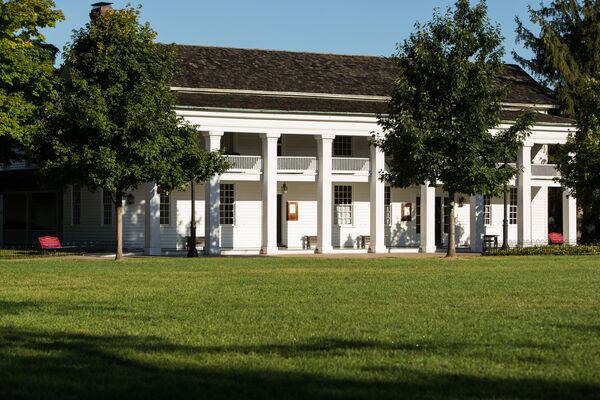
Photo by KMS Photography
When it comes to dining experiences, Eagle Tavern in Greenfield Village is one of a kind. The stagecoach tavern was built in 1831 in Clinton, Michigan. Calvin Wood and his wife Harriet operated it from 1849 to 1854, offering food, drink, and accommodations to the locals and those who came through the town. In 1927, Henry Ford purchased the tavern and brought it to Greenfield Village as the Clinton Inn, where it first served as a cafeteria for Edison Institute students and then for visitors. In April 1982, Eagle Tavern officially opened as the restaurant we know today. Forty years later, Eagle Tavern continues to delight members and guests with mid-1800s food and drink.
As we celebrate the beginning of the 2022 Greenfield Village season, Sous Chef Kasey Faraj shares three of his favorite Eagle Tavern recipes for you to try at home.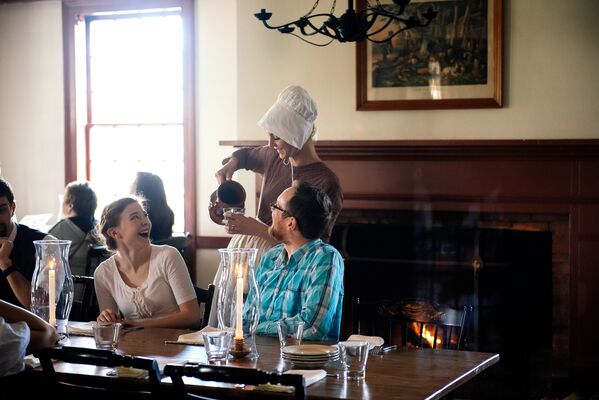
Photo by Emily Berger
“My absolute favorite thing about the tavern is the overall guest experience,” said Faraj. “There is simply no place like this anywhere in America where we are taking our guests on a journey to the past. Everything from our Calvin and Harriet Wood characters chatting with our guests to the food, to the look of the bill of fare and restaurant, and the servers in period clothing, we all collectively create an experience that is unique, historically accurate, and unmatched by any establishment.”
Faraj found inspiration for his menus from classic mid-1800s era cookbooks, like Mrs. Putnam’s Receipt Book and The Kentucky Housewife. It was in these wonderful books that he was inspired to create dishes such as our delicious Asparagus Soup, Pork and Potato Balls, and Bouilli Beef.
Eagle Tavern’s Asparagus Soup
serves many
Ingredients
- ½ pound unsalted butter
- 1 ½ cups yellow onion, medium dice
- 1 teaspoon fresh garlic, minced
- 5 pounds asparagus, trimmed
- 1 ½ cups celery, diced
- 2 bay leaves
- ¾ gallon vegetable broth
- ½ cup cornstarch
- 1 quart half-and-half
- Salt and pepper to taste
Method
- Heat a stockpot and melt the butter.
- Add the onions and garlic and cook over medium-high heat until onions are translucent.
- Add the asparagus, celery, bay leaves, and vegetable broth. Bring to a boil.
- Once boiling, turn heat to low and simmer until asparagus is tender.
- Add the cornstarch and half-and-half and puree the mixture with a hand blender until smooth. (You can also slowly break down the asparagus with a potato masher.)
- Add salt and pepper to your liking.
- Adjust the cornstarch if thicker or thinner soup is desired.
- Strain if you wish to have a lighter-style soup. Serve with fresh bread or crackers.
“The awesome curators here at The Henry Ford and I collaborate to find these menu items in cookbooks from the past,” said Faraj. “I then take said items and build the menu through both seasonal availability and the story of Harriet and Calvin Wood. It is not as simple as, ‘I found a recipe for a mid-1800s era style corn soup, so we are going to offer that soup.’”
Faraj and team take everything into consideration:
- How did season and local availability influence the meals that a tavernkeeper like Harriet Wood might have prepared for her tavern customers?
- What foodstuffs could have been imported in southern Michigan in 1850?
- What type of meals and desserts might Harriet Wood have had time to prepare over an open hearth in her busy tavern kitchen?
“In-depth research from period American cookbooks found in our research center, and expertise from our curators, help us find our way to these answers,” he said. “The ability to find a recipe from a book written almost two centuries ago, test that recipe, and then place it on a menu (that is seasonally accurate!) is what makes a chef working in historic dining challenging—yet fun!”
Eagle Tavern’s Pork and Potato Balls
serves many
Ingredients
- 3 pounds cooked Idaho potatoes
- 3 fresh eggs
- 1 pound cooked pork-sage sausage, crumbled
- Salt and pepper to taste
- 1 pound unsalted butter
Method
- Put cooked potatoes in a large mixing bowl. Using a potato masher, mash the potatoes until there are very few lumps.
- In a separate bowl, whisk the eggs.
- Add the crumbled sausage, salt, and pepper to the eggs and mix until evenly distributed.
- Using a spoon or a small scooper, shape the mix into small balls no larger than a golf ball.
- Heat a nonstick pan and melt the butter.
- Cook the balls in the butter until browned on all sides and the internal temperature is 165° F. When cooked, sprinkle with additional salt and pepper and serve with extra butter, if desired.
One last recommendation from Chef Faraj: Eagle Tavern’s Bouilli Beef. “This dish is great served with roasted potatoes and mashed parsnips,” he said.
Eagle Tavern’s Bouilli Beef
serves many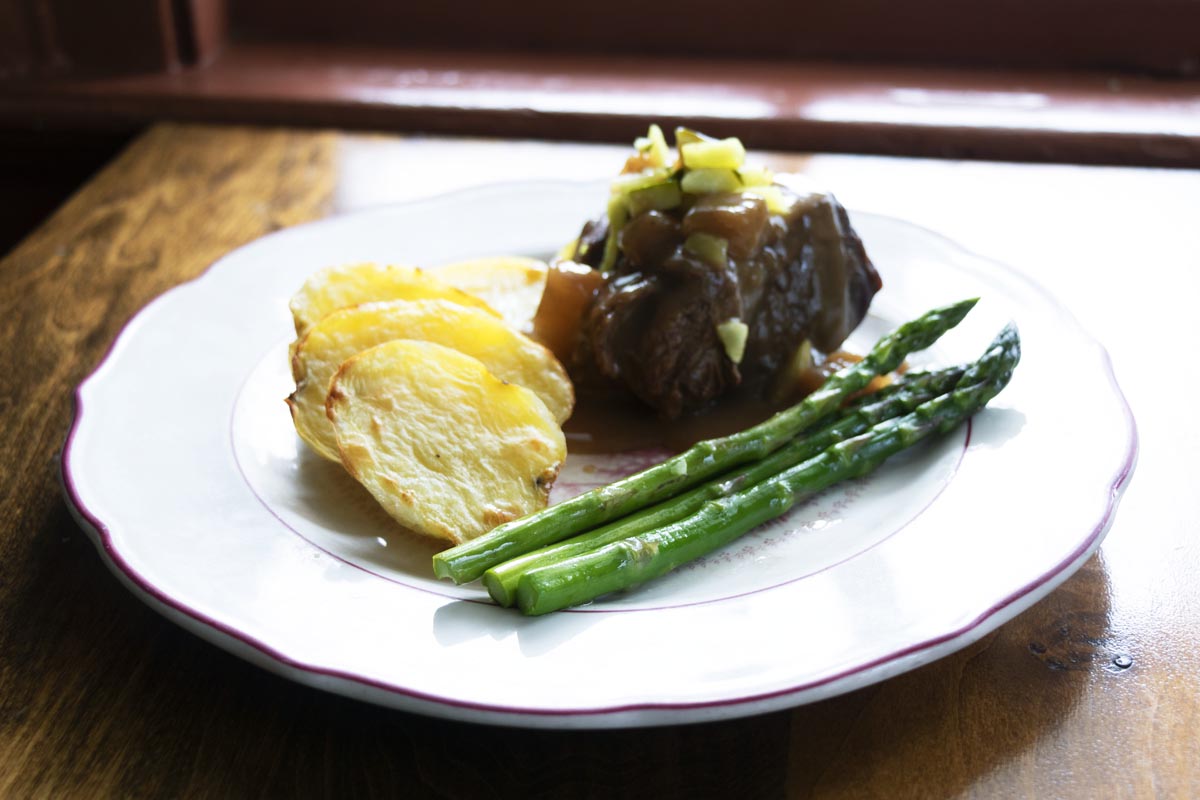
Ingredients
- 3 pounds beef, cut into 8-oz. portions (preferably chuck eye roll)
- Salt and pepper to taste
- 3 ounces vegetable oil
- 1 pound turnips, cut into 1-inch pieces
- ¼ pound yellow onion, medium dice
- ¼ pound peeled carrots, medium dice
- ¼ pound celery, medium dice
- 1 ½ gallons beef stock
- 2 bay leaves
- ½ teaspoon ground cloves
- 6 cloves fresh garlic
- 1 ounce soy sauce
- 2 ounces Dijon mustard
- 4 ounces cornstarch
- 4 ounces chopped sweet pickles
Method
- Season the beef with salt and pepper. Heat the vegetable oil in a stockpot on the stove and sear the meat on all sides.
- Add the rest of the ingredients except for the soy sauce, mustard, cornstarch, and pickles.
- Bring it all to a boil; once boiling, turn the heat down to a low setting and cover. Let cook slowly until the meat is almost fall-apart tender, 2-3 hours. Turn off and leave on stove.
- Take half the stock the beef was cooked in and strain. Whisk together the soy sauce, mustard, and strained stock in a small saucepot over medium heat. Add the cornstarch and bring to a slow boil; cook until gravy is slightly thick. Add the cooked beef and plate with the turnips it was cooked with.
- Ladle 2-3 ounces of gravy over each piece and top with chopped pickles.
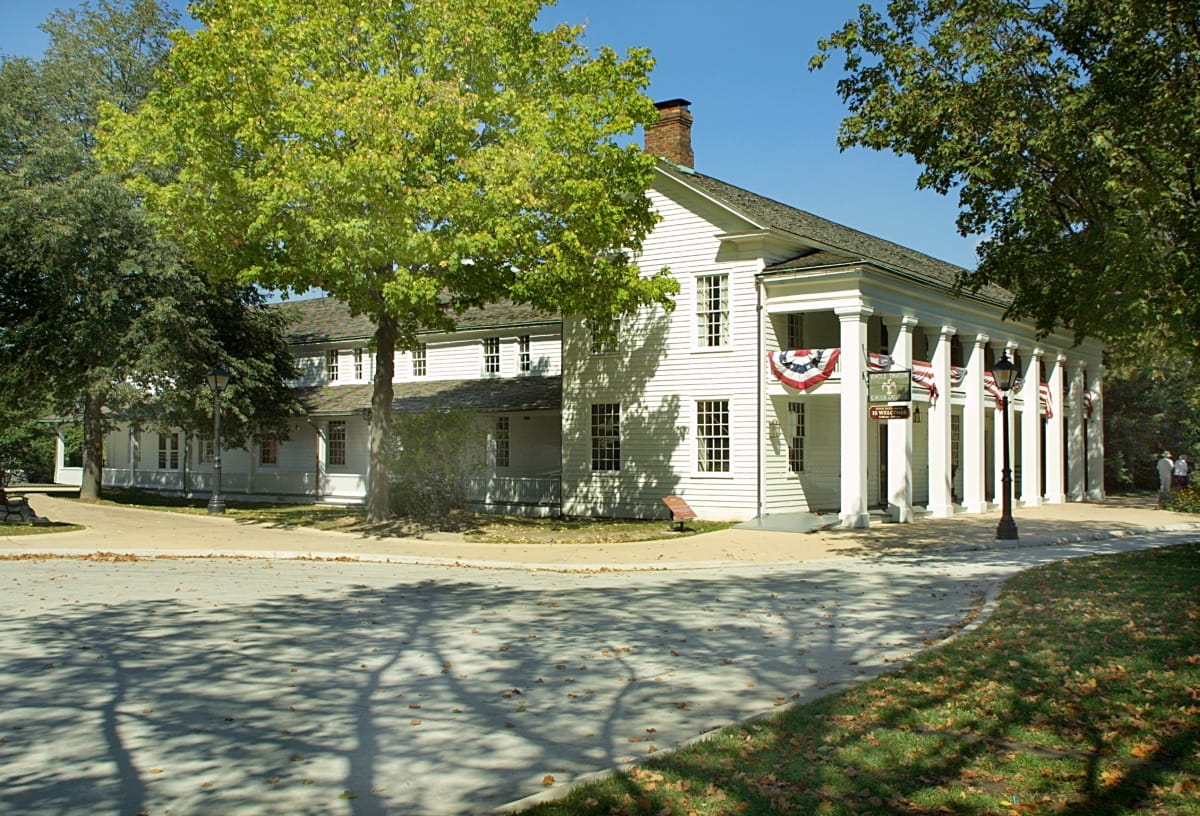
Eagle Tavern, Greenfield Village / THF1918
Want to learn more about Eagle Tavern? Look below for links to blog posts, Innovation Nation segments, and artifact records.
All About Eagle Tavern
- Artifact Record: Eagle Tavern
- Plan Your Visit
- Creating the Eagle Tavern Dining Experience
- The Henry Ford’s Innovation Nation: 1850s Dining Experience at Eagle Tavern
- 1988 Eagle Tavern Cookbook
Drink Recipes
Dig Deeper
- Greenfield Village Building Makeovers
- Meet Calvin Wood
- Drinking at Eagle Tavern
- Root Vegetables, Now & Then
- Behind the Bar at Eagle Tavern
Lish Dorset is Marketing Manager, Non-Admission Products, at The Henry Ford.
making, Michigan, recipes, food, restaurants, by Lish Dorset, Greenfield Village buildings, Greenfield Village, Eagle Tavern
Frank Kulick: Early Ford Racer

Frank Kulick sitting in a 1910 Ford Model T race car. / THF123278
Frank Kulick (1882–1968) was a lucky man who beat rivals and cheated death on the race track. But his greatest stroke of luck may have been being in the right place at the right time. Born in Michigan, Kulick started his first job—in a Detroit foundry—at age 12. He was listed as a spring maker in the 1900 census. But in 1903 he was working for Northern Manufacturing Company—an automobile company founded by Detroit auto pioneer Charles Brady King.
That’s where Frank Kulick met Henry Ford.
Ford stopped by Northern to borrow a car. Impressed with young Kulick, Ford lured him to his own Ford Motor Company, where Kulick signed on as one of Ford Motor’s first employees. Kulick was there at Lake St. Clair in January 1904 when Henry Ford set a land speed record of 91.37 miles per hour with his “Arrow” racer. Not long after, Ford told Kulick, “I’m going to build you a racing car.” By that fall, Frank Kulick was driving to promote Ford Motor Company on race tracks and in newspapers.
Frank Kulick scored his early victories driving this four-cylinder Ford racer. Its engine consisted of a pair of two-cylinder (1903) Model A engines mated together. / THF95388
Kulick went head-to-head with drivers who became legends in American motorsport—people like Barney Oldfield, whose cigar-chomping bravado set the mold for racing heroics, and Carl Fisher, who established Indianapolis Motor Speedway in 1909 and the Indianapolis 500 two years later. Kulick firmly established his credentials with an improbable win at Yonkers, New York, in November 1904. Through skillful driving in the corners and a bit of good luck (which is to say, bad luck for his competitors), Kulick’s little 20-horsepower Ford pulled out a win against a 90-horsepower Fiat and a 60-horsepower Renault. Kulick covered a mile in 55 seconds—an impressive racing speed of 65 miles per hour.
Frank Kulick (second from right) and Henry Ford (third from left) were photographed in New Jersey with the Model K racer in 1905. / THF95015
Frank Kulick’s four-cylinder, 20-horsepower car was superseded in 1905 by a larger car with a six-cylinder, 60-horsepower engine. It was one of a series of cars using engines based on the six-cylinder unit that appeared in the Ford Model K. The bigger engine did not bring better results. Henry Ford himself drove one of the cars twice in the summer of 1905, chasing new land speed records on the New Jersey beach. But the car came up short each time.
With Kulick at the wheel, Ford tried again for a record at Ormond Beach, Florida, in January 1906—this time with the six-cylinder engine improved to 100 horsepower. But Kulick had trouble with the soft sand, and he managed no better than 40 miles per hour on the straightaway. (The record was broken at the Ormond Beach event—but by a steam-powered Stanley that hit 127.66 miles per hour.)
The end of the road for Ford’s six-cylinder racers nearly ended Frank Kulick’s career—and his life. It happened in October 1907, on the one-mile oval at the Michigan State Fairgrounds near Detroit. Kulick was trying to lap the dirt track in fewer than 50 seconds—a speed better than 72 miles per hour. His latest car was dubbed “666”—a name that simultaneously called attention to its cylinder count and paid homage to Henry Ford’s earlier “999.” In retrospect, that nefarious name was a bad omen.
Miraculously, Frank Kulick survived this crash in 1907, but it left him with a broken leg and a permanent limp. / THF125717
As Kulick was going through a turn on the fairgrounds oval, his rear wheel collapsed. Car and driver went careening off the track, through the fence, and down a 15-foot embankment. When rescuers arrived, they found Kulick some 40 feet from his wrecked racer. He was alive, but with his right kneecap fractured and his right leg broken in two places. Frank Kulick survived the crash, but his injuries healed slowly and imperfectly. He wore a brace for two years, and he walked with a limp for the rest of his life—his right leg having come out of the ordeal 1 ½ inches shorter than his left leg. The “666” was repaired, but it never competed again.
Henry Ford was horrified by Kulick’s accident, and he very nearly swore his company off racing for good. It wasn’t until 1910 that Kulick competed again under the company’s colors. By then, Ford Motor Company wasn’t building anything but the Model T, so Kulick naturally raced in a series of highly modified T-based cars. Arguably, his first effort in the renewed campaign was more show business than sport. Kulick went to frozen Lake St. Clair, northeast of Detroit, that February to challenge an ice boat. He easily won the match and earned quick headlines for the Model T.
Kulick posed in a Model T racer at the Algonquin Hill Climb, near Chicago, in 1912. / THF140161
Over the next two years, Kulick and his nimble Model T racers crossed the country competing—and frequently winning—road races and hill climbs. Despite Kulick’s success, Henry Ford remained lukewarm on racing. Ford Motor Company built nearly 70,000 cars in 1912 and still struggled to meet customer demand, so it certainly didn’t need the promotion—or problems—that came with an active motorsport program. Kulick later recalled that, after a race at Detroit in September 1912, Henry pulled $1,000 in cash from his pocket and told Frank, “I’ll give you that to quit racing.” Despite the generous offer (almost $30,000 in today’s dollars), Kulick continued a bit longer.
Frank Kulick may have started having second thoughts the next month. While practicing for the Vanderbilt Cup road race in Milwaukee, he grew concerned about the narrow roadway. There wasn’t enough room to pass another car without dipping into a ditch, so Kulick protested and dropped out of the contest. His concerns proved well founded when driver David Bruce-Brown was killed in the next round of practice.
It was the 1913 Indianapolis 500 that finally changed Kulick’s career path. Then in its third running, the Indy 500 was well on its way to becoming the most important race in the American motorsport calendar. Henry Ford was determined to enter Kulick in a modified Model T. But Indy’s rules specified a minimum weight for all entries. The Ford racer weighed in at less than 1,000 pounds—too light to meet the minimum. Indy officials rejected the modified T, and a frustrated Henry Ford reportedly replied, “We’re building race cars, not trucks.” With that, there would be no Ford car in the Indianapolis 500—in fact, there would be no major factory-backed Ford racing efforts for 22 years.
Kulick’s later career involved more genteel assignments, like driving the ten millionth Ford on a coast-to-coast publicity tour in 1924. Here, he takes a back seat to movie stars Mary Pickford and Douglas Fairbanks. / THF134645
Frank Kulick’s racing days were over, but he remained with Ford Motor Company for another 15 years. His assignments varied from research and development to publicity. In 1924, Kulick was charged with driving the ten millionth Ford Model T on a transcontinental tour from New York to San Francisco. Three years later, Kulick was called on to help celebrate the 15 millionth Model T. This time, rather than driving it across the country, Kulick—as one of Ford Motor Company’s eight senior-most employees—had the honor of helping stamp digits into the engine’s serial number plate. It was perfectly fitting that, as someone who’d done so much to promote the Model T through racing, Kulick was there to make his mark on the ceremonial last T. Kulick left Ford not long after that. He had done well investing in real estate, which afforded him a comfortable retirement.
Frank Kulick passed away in 1968. He survived to see Ford Motor Company achieve its great racing triumphs at Indianapolis and Le Mans during the “Total Performance” era. He also lived long enough to sit for an interview with author Leo Levine, whose 1968 book, Ford: The Dust and the Glory, remains the definitive history of Ford racing in the first two-thirds of the 20th century. Levine wrote a whole chapter on Frank Kulick—but then, Frank Kulick wrote a whole chapter in Ford’s racing history.
Matt Anderson is Curator of Transportation at The Henry Ford.
Additional Readings:
- Remembering Al Unser, Sr. (1939-2021)
- Eight Questions with Vaughn Gittin, Jr.
- Race Cars of Driven to Win
- 2016 Ford GT Full-Size Clay Model, 2014
Michigan, Model Ts, Indy 500, cars, by Matt Anderson, Ford workers, Ford Motor Company, Henry Ford, race cars, race car drivers, racing

